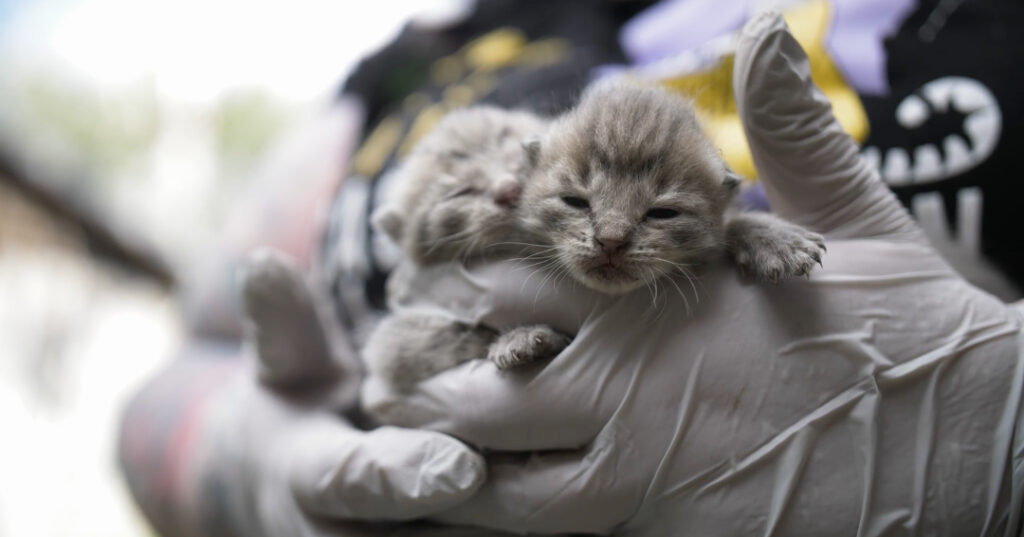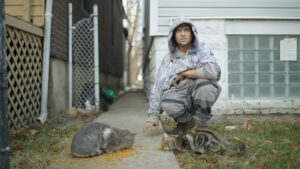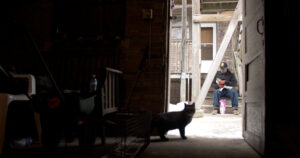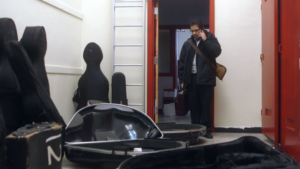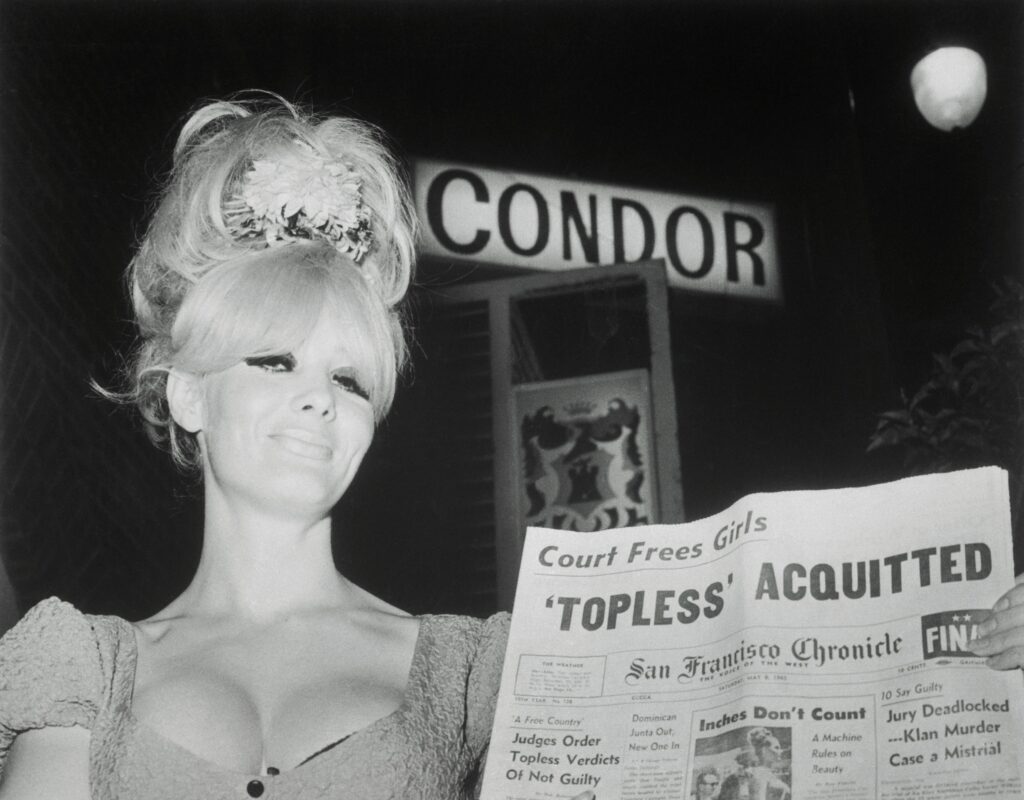April 22, 2024
by Carla Hay

Directed by Kevin Macdonald
Some language in French with no subtitles
Culture Representation: The documentary film “High & Low – John Galliano” features a predominantly white group of middle-class and wealthy people (with a few black people and one Asian) who are interviewed about controversial British fashion designer John Galliano, who has worked for fashion brands such as Givenchy, Christian Dior (also known as Dior) and Maison Margiela.
Culture Clash: In 2011, Galliano had a fall from grace after a December 2010 video surfaced of him going on an antisemitic and racist rant, but he has attempted to clean up his reputation since then.
Culture Audience: “High & Low – John Galliano” will appeal primarily to people interested in documentaries about the fashion industry and controversial famous people.
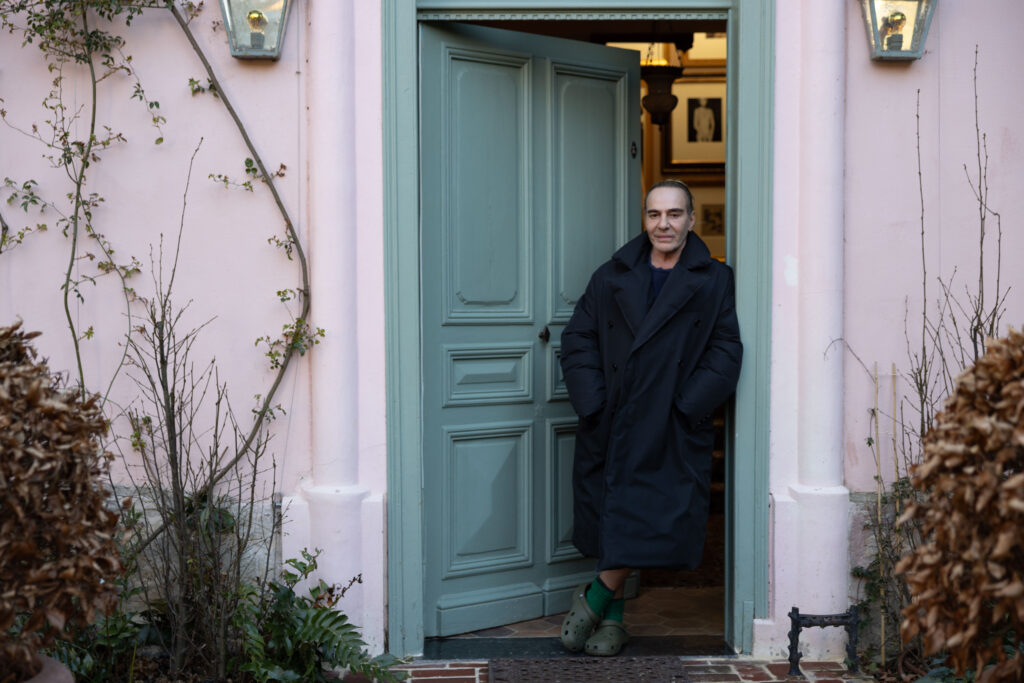
When all is said and done, “High & Low – John Galliano” is really about answering this question: “Does someone who was exposed for being antisemitic and racist deserve to make a career comeback?” This biographical documentary works better as a “where are they now” story than as a convincing argument that disgraced fashion designer John Galliano deserves to make a comeback. The movie has indications that Galliano’s sincerity can be doubted. Even with some celebrities praising Galliano in the movie, what really matters is what Galliano has done to make amends for the harm that he has caused and prove that he is truly reformed.
Directed by Kevin Macdonald, “High & Low — John Galliano” (which has exclusive interviews that were filmed from January 2022 to March 2023) includes the participation of Galliano, who ostensibly agreed to do this documentary so that it could be a showcase or platform for what he clearly wants to be his full redemption. According to the production notes for “High & Low — John Galliano”: “Galliano and Macdonald started talking on Zoom during the first lock-down in the summer of 2020. They first met in person in the spring of 2021 and that led to a ‘trial interview’ in August 2021.” “High & Low — John Galliano” had its world premiere at the 2023 Telluride Film Festival and made the rounds at several other film festivals that year, including the Rome Film Festival and BFI London Film Festival.
Born in the Britsh territory of Gibraltar on November 28, 1960 (as Juan Carlos Antonio Galliano), he was at the top of the fashion industry as artistic director of fashion brand Christian Dior when he was fired in 2011, after a December 2010 video surfaced of Galliano making antisemitic and racist remarks to a stranger at an outdoor cafe in Paris. It wasn’t an isolated incident. When asked about other bigoted comments that that he allgedly made in public, Galliano admits in the documentary that it’s possible he could have made other hate speech comments in his life, but those incidents weren’t recorded. Using drunken blackouts as an excuse, Galliano says he doesn’t remember a lot of horrible things that he’s done that people said that he did.
In the antisemitic rant that was caught on video, Galliano said to a woman whom he thought looked Jewish: “I love Hitler … People like you would be dead. Your mothers, your forefathers would all be fucking gassed.” For his antisemitic and racist rant that was caught on video, Galliano made public apologies, partially blaming being drunk at the time that he made these hate speech comments.
Because making antisemitic commentary is illegal in France, Galliano was charged with this crime and went to trial in 2011. He was found guilty and got a sentence of €6,000 in suspended fines. Galliano also talks about voluntarily receiving sensitivity training and education from the Anti-Defamation League (ADL). This information is confirmed in the documentary by former ADL director Abraham Foxman, who says he was one of the few ADL leaders who wanted to meet with Galliano.
After getting fired from Dior for this bigotry scandal, Galliano became a pariah in the fashion industry for a few years. And then, he was hired in 2014 to be creative director of Maison Martin Margiela, now known as Maison Margiela. Although Galliano was able to crawl back to the industry for this lower-profile job, it’s obvious from watching the documentary that he wants to be back among the A-list designers. It’s unlikely he will ever return to the career heights that he had when he torpedoed his career.
“High & Low – John Galliano” will give viewers a lot of information about Galliano’s personal life and career, which the documentary tells in chronological order. Galliano admits that he’s a recovering alcoholic who’s been sober for “years.” (Galliano doesn’t get more specific about how long he’s been allegedly sober.)
He also hints at having many other addictions (he admits to abusing cocaine during the height of his career), but alcoholism, plastic surgery and a physical workout craze are the only addictions he fully admits to on camera. Even with these admissions, it’s hard to be convinced that Galliano is truthful in his claims to be clean and sober, when he is sometimes slurring his words and appears glassy-eyed and occasionally unfocused during his interviews in this documentary.
Galliano also apparently never personally reached out to say he was sorry to the people who were the targets of his illegal insults in that notorious December 2010 rant. Galliano claims that he was advised by his attorney at the time not to speak to the victims before the case was resolved. However, the court case has been resolved since 2011. He’s had plenty of time to make these amends, but he hasn’t done that, according to Philippe Virgitti, a dining companion of the woman who was the target of Galliano’s antisemitic and illegal rant in the December 2010 video.
Virgitti, who is interviewed in the documentary, was dining with this woman when Galliano spewed this bigoted hate in that December 2010 incident, so Virgitti saw firsthand what happened. Virgitti says that what wasn’t caught on video was Galliano saying other racist and antisemitic things to Virgitti (who has Asian heritage) and Virgitti’s dining companion. Although Galliano claims that he eventually made personal apologies to his victims by reaching out to them privately, Virgitti and Virgitti’s attorney Jean-Bernard Bosquet-Denis say that claim it isn’t true, and Galliano never made these private amends. Virgitti says the only apologies that he and his female companion got from Galliano were public and impersonal statements, which Virgitti believes are insincere apologies.
To the documentary’s credit, the movie’s very first scene addresses the controversy about Galliano by showing the notorious video. In an interview for the documentary, Galliano says of his antisemitic rant: “It was a disgusting thing, a foul thing that I did. It was just horrific.” Macdonald (who is also one of the documentary’s producers) can be heard off-camera asking, “Can you tell me how you ended up in that place?” Galliano replies, “I’ll tell you everything.” Galliano then pauses to light a cigarette and says, “I’ve got the shakes, so I need a cigarette.”
It’s compelling way to start the documentary, which then goes into telling the story of Galliano’s career rise, fall and attempted comeback. What emerges is a portrait of someone who’s had issues with addiction and anger for years—even before he was famous—but he was enabled by too many people because of his artistic talent, because he had a very charismatic side to his personality, and because he was making tons of money for a lot of people. In the documentary, Galliano says his workload was insane at the height of his career, and he turned to various addictions to cope.
Galliano grew up in a family consisting of his father Juan Galliano (of Italian heritage), who was a plumber; John’s mother Ana “Anita” Guillén (of Spanish heritage); and John’s two sisters. The family moved from Gibraltar to the United Kingdom when John was 6 years old. John’s older sister Rosemarie Husband, one of the people interviewed in the documentary, remembers their childhood this way: “I always had to look after John. He was quite disruptive. He wanted attention all the time.”
John says that he knew from a very early age that he is gay. One of the earliest indications of his interest in fashion was that he used to wear his mother’s makeup and clothes when he was a boy. John had a troubled relationship with his father, whom John describes as “very straight” and physically and emotionally abusive. John says his father could be violent if “I stepped out of line.” John remembers an incident when his father beat him up after John made this offhand comment about a young man he saw on TV: “Oh, he looks gorgeous.”
Just like many LGBTQ people with homophobic family members, John found a family of friends who accepted him and his sexuality. John’s first “found family” was in the fashion and artistic community in London, in the early-to-mid 1980s, when he attended and graduated from St. Martin’s School of Art. It was a life-changing experience for him.
John explains in the documentary: “During the [Margaret] Thatcher years, I wasn’t joining marches and things like that. I was into sketching and drawing. I ended up prepping a portfolio for St. Martin’s School of Art. They took on few people. The competition was really strong, but they gave me a place and a grant. I saw like-minded people. It was like, ‘My God, I’m not the only one.'”
David Harrison, a painter artist who was one of John’s friends at St. Martin’s School of Art, remembers: “He was very shy when I first met him. And I sort of loosened him up a bit. I always felt like I was his big sister.” (John claims that former Sex Pistols manager Malcolm McLaren had once wanted Harrison to be the lead singer of the Sex Pistols, but Johnny Rotten, now known as John Lydon, ended up with the gig.)
Harrison says that he influenced John to go from having very suburban, designer-label taste in fashion to wearing vintage clothes. Harrison also talks about the dark side of John as an “out-of-control drunk. You’d have to sort of look after him.”
It was during his years at St. Martin’s School of Art that John says he became obsessed with the 1927 documentary “Napoleon,” directed by director Abel Gance. Napoleon Bonaparte and the 1800s fashion during this French leader’s reign also heavily influenced John’s fashion aesthetic for years. John took the advice of a St. Martin’s School of Art teacher to cut clothes like he draws, which is how John says he learned how to be a fashion designer.
His 1984 graduation fashion show “Les Incroyables” (“The Incredibles”) showed these influences in genderless clothes. The show was a big hit and got John noticed by many influential people in the fashion industry. In the documentary, fashion journalist/editor Hamish Bowles describes “Les Incroyables” as “one of the top five fashion shows I’ve ever seen. It was absolutely astonishing … You thought, ‘Here’s someone who was touched with genius.'”
Suzanne Von Aichinger—a former model who says she was John’s muse for years—makes a comment about John that probably inspired the title of this documentary: “He really had the high/low [sense of fashion]. He really knew how to balance the two.”
Even with some financial rough patches in the early years, high-profile work came fairly quickly for John, who worked as an in-demand independent designer with his own label, which he maintained, even after he was hired as the director of corporate-owned fashion brands. In 1989, he relocated to Paris, where his career soared to new heights. He became the head designer for Givenchy from July 1995 to October 1996, when he was named artistic director for Christian Dior, also known as Dior. Givenchy and Dior are both owned by luxury goods corporation LVMH.
But behind the glitz and glamour of this success, John still had a reputation for being a hellraiser with a nasty temper. Marie-Sophie Wilson, a former model who was one of John’s friends in the 1980s and 1990s, says that when he moved to Paris, she gave him a place to stay with her because he couldn’t afford rent for his own place. “He camped on my settee and destroyed my washing machine,” Wilson remembers.
Wilson comments: “There are definitely two Johns. There is a shy John and there is a quite mad John. He was a bad drunk. He really wants to get wasted until he drops.” Fashion editor Tim Blanks remembers John urinating on people without their consent in a nightclub. “He was just so off it,” Blanks says. “I just thought, ‘Boy, this guy is unhappy.'” Later in the documentary, John admits that even after he became a rich and famous designer, he was permanently banned from some hotels because of the awful things that he did.
Despite all of these warning signs, John continued to thrive in the industry. And it’s easy to see why. The documentary has several people who make excuses for him or won’t comment on his troubling actions that would get most people arrested if they don’t have fame, wealth and connections. Most of the people who have a financial incentive to praise John do nothing but praise John in the documentary.
One of his most vocal supporters is Anna Wintour, editor-in-chief of the U.S. edition of Vogue and chief content officer of Condé Nast, who has her own problematic history of self-admitted racism. She says, “If you think of the great designers who really changed the way women dressed or look or how we think about fashion, immediately, you knew what John was doing. You realize he was one of them, so you had to help him.”
Kate Moss, Naomi Campbell and Amber Valletta are among the past and present supermodels who consider themselves to be John’s fans and say so in the documentary. Adding their commentary are Oscar-winning actresses Charlize Theron and Penélope Cruz, who just stick to flattery about John’s fashion designs. Also interviewed are several of his former business associates. They include Sidney Toledano, CEO of Dior from 1998 to 2018; Katell Le Bourhis, former advisor to LVMH founder/chairman/CEO; and Johann Brun, who describes himself as John’s first financial backer.
Other people interviewed in the documentary are DJ/musician Jeremy Healy, who found brief fame in the early 1980s as a member of the British pop duo Haysi Fantayzee; jewelry designer Vicky Sareg; John Galliano publicist Mesh Chhibber; Vogue editorial executive Edward Enninful; New York Times fashion director Vanessa Friedman; fashion writer Colin McDowell; fashion editor Sally Singer; John’s personal assistant Evelynne Tissier; John’s agent Anne Nelson; Condé Nast chairman Jonathan Newhouse; psychiatrist Boris Cyrulnik; addiction special Dr. Phillipe Bates; and John’s friends Paul Frecker and Tricia Ronane.
John’s personal life is described as a lot of co-dependent relationships, although he seems to have found contentment with his longtime love partner Alexis Roche, who is also interviewed in the documentary, but he doesn’t say anything insightful. It’s not surprising because most live-in partners or spouses are not going to say something brutally honest in a documentary that could ruin their relationships. John does not mention the names of any other significant lovers he’s had in his life.
The documentary has stories about Steven Robinson, John’s design assistant who died of a cocaine overdose in 2007, at the age of 38. Robinson (who worked with John for more than 20 years) is described by various people in the documentary as an intensely loyal gatekeeper, cocaine addict, and John’s best friend, who was in love with John, but they never had a romantic relationship. John’s personal assistant Tissier says of the relationship that Robinson had with John: “This co-dependency had some very toxic aspects.”
Parts of the documentary are meant to pull at the heartstrings. There’s a scene where John describes his mixed emotions over the end of his father’s life. John claims that his ailing father, who rarely expressed his approval of John, told John that he loved John before he died. However, John’s sister says in the documentary that she had to beg John to attend the funeral because John was busy with fittings for his next big fashion show. John says he took a private jet to the funeral and flew right back to work as soon as he could.
A “dramatic” part of the documentary is toward the end when John is invited to look at a special Dior archive collection. It’s the first time that he’s been allowed to set foot in this part of Dior headquarters since he was fired in 2011. John is visibly nervous and emotionally touched, but he also expresses pride and wonderment when he looks at the Dior clothing that he designed.
Viewers can look beyond these misty-eyed moments and lavish praise of a celebrity to see the heart of the matter. The measure of someone’s true character isn’t how talented that person is or how much money that person can make but how that person treats others and how that person reacts when caught doing something wrong. By those standards, people who watch “High & Low – John Galliano” can make up their own minds on what type of character he really has and how sincere he is.
MUBI released “High & Low – John Galliano” in select U.S. cinemas on March 8, 2024. MUBI will premiere the movie on April 26, 2024.

